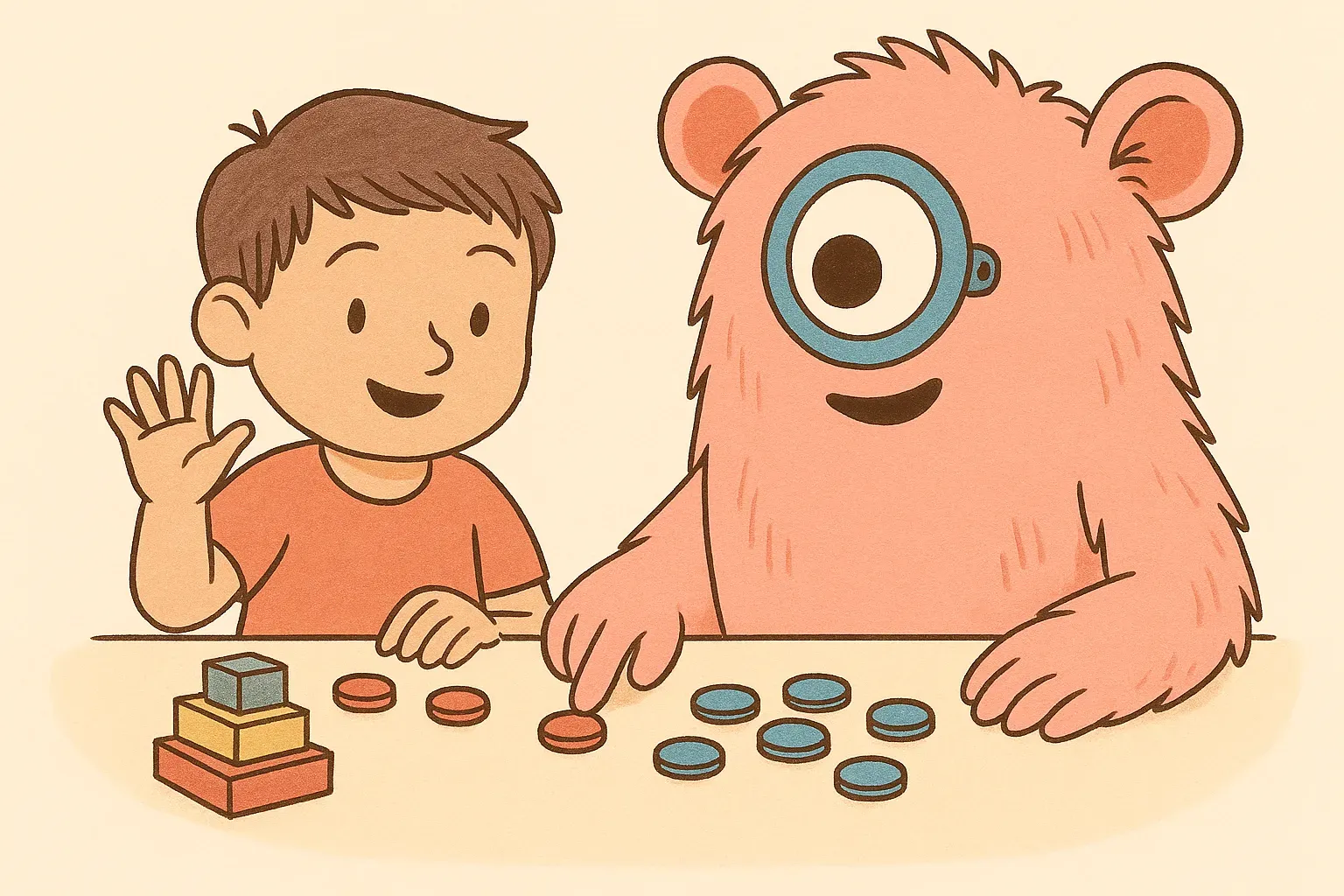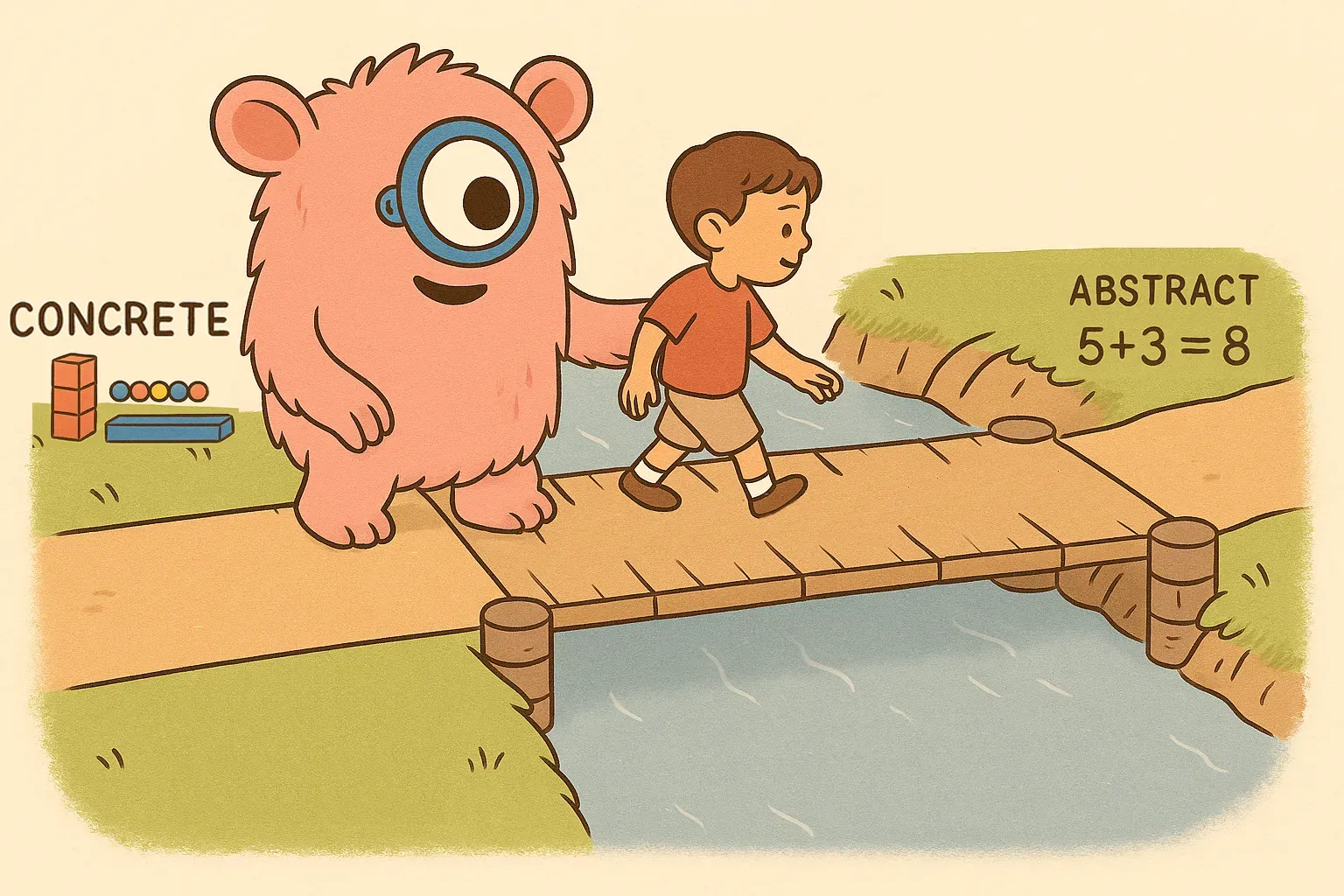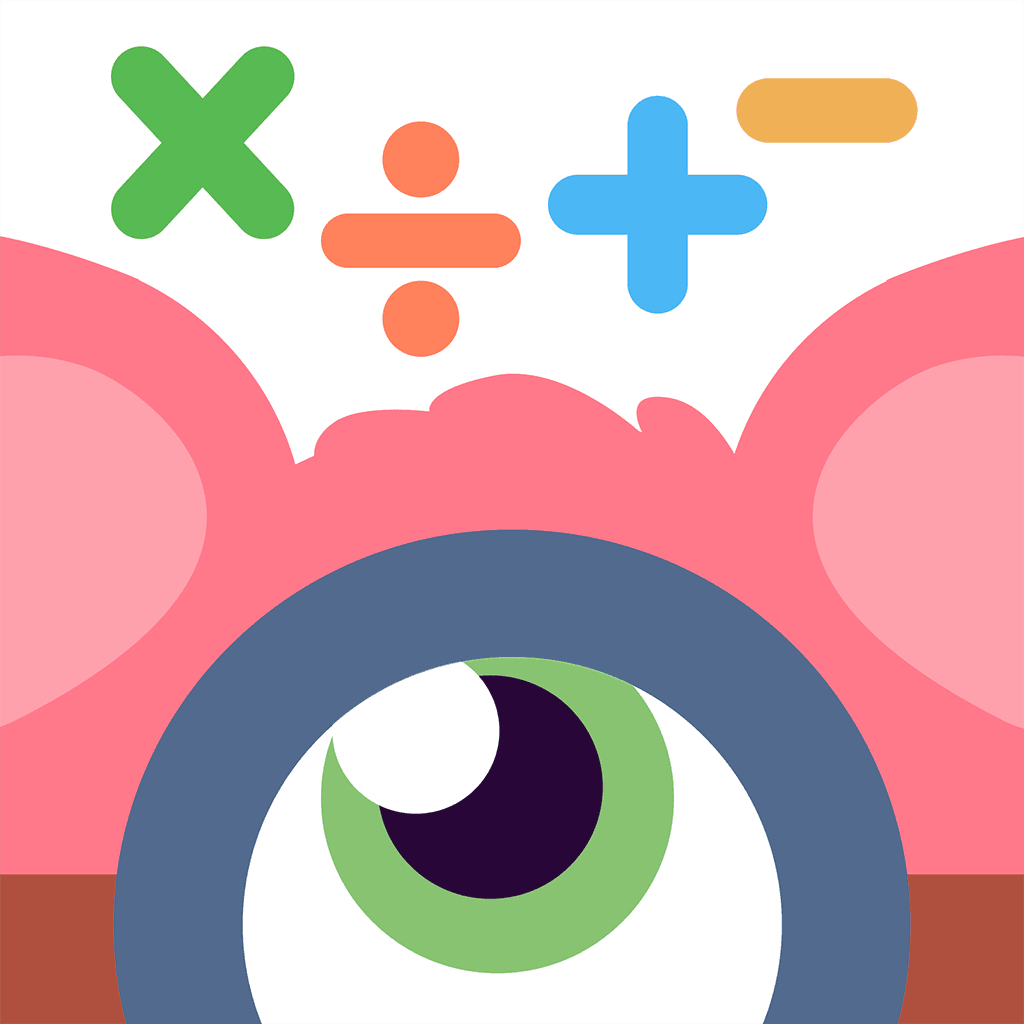Bridging the Gap: Helping Neurodivergent Learners Transition from Counting to Abstract Math
TL;DR: Neurodivergent learners often excel with hands-on math but struggle when faced with abstract symbols alone. The key is a gradual transition: start with concrete counting (using manipulatives like blocks or fingers), then introduce visual representations and symbols, and finally move to formulas and mental math. Research-backed strategies like the Concrete–Representational–Abstract (CRA) approach engage multiple senses and help learners form lasting understanding at each stage. With patience and the right scaffolding, children with ADHD, autism, dyscalculia and other learning differences can successfully bridge the gap from counting to abstract math.
Why the Leap from Concrete to Abstract Is Hard for Neurodivergent Learners
For many neurodivergent children, math understanding begins with tangible experiences. They count on their fingers, stack blocks, or use tokens to “see” the numbers. However, when math instruction jumps to abstract symbols (like writing “7 + 5 = 12” on a board), these learners can feel lost. The human brain isn’t naturally wired to manipulate abstract symbols – it builds math understanding by linking symbols back to real quantities and experiences. Studies using brain imaging confirm that even in typical learners, areas involved in visual and spatial processing light up during arithmetic, showing how intertwined imagery is with numeric reasoning (Geary et al., 2008).
For neurodivergent students – including many with ADHD or autism – this need for visual, concrete context is even greater. They may have strong visual-spatial strengths or, conversely, difficulties with working memory and language processing that make purely symbolic math overwhelming. A classic example is a child who can count objects perfectly, yet struggles to solve “8 + 5” without counting out loud or on fingers. As we discuss in our post on "Moving from counting to adding", being “stuck” in counting mode is common – and not just laziness or habit. It often signals that the child hasn’t formed the mental connection between the act of counting and the concept of addition.

Neurodivergent learners are especially at risk of this because they might lean heavily on concrete aids. For instance, children with dyscalculia rely on finger counting or other aids to even grasp basic number concepts; without these supports, numbers feel abstract and confusing. A 2020 longitudinal study found that students with developmental dyscalculia consistently relied on finger-based strategies long after peers had moved to mental calculation, due to impaired memory retrieval (McCaskey et al., 2020).
Another factor is working memory. ADHD doesn’t inherently impair a child’s ability to understand numbers, but it does make it harder to hold multiple pieces of information in mind. Solving even a simple addition problem abstractly requires remembering the addends, carrying if needed, etc., all in one’s head. A recent neuropsychology study confirmed that math difficulties in children with ADHD stem primarily from working memory and attention weaknesses, rather than core number sense deficits (Gaye et al., 2024).
Autistic learners, on the other hand, often have a very detail-focused, visual thinking style. They might excel at detecting patterns or quickly recognizing quantities in visual form. In fact, a 2024 study found that autistic students outperformed their neurotypical peers in rapid subitizing tasks (recognizing how many dots are present without counting), highlighting their strength in visual processing of numerosity (Flores et al., 2024). Yet these same students often struggle when numbers are presented as bare symbols with no context or visual anchor.
The Power of Manipulatives: Why “Hands-On” Comes First
Manipulatives are physical objects that represent numbers or math concepts – think of counters, blocks, beads, fraction tiles, abacus beads, or even fingers on a hand. These concrete tools are not “baby math” or mere playthings; they are fundamental building blocks for understanding. A large meta-analysis covering 55 studies across K–college found that using manipulatives improved math performance significantly compared to purely abstract instruction, especially in retention and conceptual understanding (Carbonneau et al., 2013).
Why are manipulatives so effective? For one, they offload cognitive demand. Instead of a child with ADHD having to keep track of numbers in their head (which taxes working memory), they can literally see and touch the quantities. Five blocks on the table and three blocks added make a visible, countable eight – there’s no mystery about what “5 + 3” means. This aligns with findings that math instruction incorporating visual and physical interaction supports working memory limitations in children with attention differences (Gaye et al., 2024).
This concrete stage mirrors how children naturally develop math intuition. Neuroscience shows that the brain’s “number sense” originates in perceptual systems — like estimating how many bananas are in a bunch — long before formal symbols are learned. Manipulatives tap into this intuitive, embodied cognition. They also engage multiple senses, which can boost memory and learning for neurodivergent students who thrive with multisensory input. That’s why special education programs for dyscalculia, ADHD, and autism often begin with highly tactile, visual approaches (Flores, 2009).
Parents and teachers may worry: if a child “always needs blocks or fingers,” won’t they fall behind? Not at all. These tools are scaffolds, not crutches. When used intentionally, they help the learner build a deep understanding that supports eventual symbolic fluency. In fact, learners who internalize math through manipulatives often transition more smoothly to abstract methods than peers who were rushed into memorization without comprehension (Swanson, 2015).
The key is to phase manipulatives out gradually, not abruptly. When a child solves “5 + 3” by instantly grabbing 5 red beads and 3 white ones - and can visually subitize the total - that’s a sign the idea is taking root. But if they still count each bead one by one, they may not be ready to move on yet. A deliberate bridge is needed: the representational stage.
From Manipulatives to Symbols: Bridging with Visual Representations
Moving from the concrete to the abstract is not an overnight jump – it’s a bridge, and the planks of that bridge are visual representations. In educational circles, this middle step is often called the representational or pictorial stage. Here, instead of physically moving objects, the child draws pictures, uses diagrams, or imagines the scenario. They might sketch five circles and add three more to represent 5 + 3, or use a drawn number line to “hop” forward in addition. Essentially, we replace the tangible objects with drawings or symbols that still carry some of the concreteness.
Visual supports are incredibly powerful for neurodivergent learners. Even something as simple as a number line can solidify understanding. Many children - especially those with dyscalculia - struggle to place numbers correctly on an imagined number line without enough hands-on experience. Studies confirm that number line interventions can significantly improve both estimation and fluency (Geary et al., 2008).
In one intervention, students used manipulatives and a number line together - for instance, physically hopping a marker 3 spaces to add 3 - and learned to “count on” rather than always starting from 1. This technique builds the mental number line, which is critical to arithmetic fluency (Flores, 2009).
Other visual tools include ten-frames (to show quantities up to 10 in familiar patterns), bar models or strip diagrams (to represent parts and wholes), and drawn groups or tallies. These aren’t “baby math” — they’re critical scaffolds. One randomized study found that third graders with math difficulties who used structured visual representations outperformed peers who relied only on verbal or rote strategies, especially in word problem solving and generalization (Swanson, 2015).
Many neurodivergent learners personalize this stage. Visual thinkers may create stories or vivid imagery to support problem-solving. That’s not a weakness - it’s an asset. A child might imagine apples or spaceships to understand 7 + 4. Over time, we help them simplify those visuals. They may move from detailed drawings to stick figures to just imagining the groups - a natural progression from representation to abstraction.

One widely endorsed framework for this process is the Concrete–Representational–Abstract (CRA) sequence. It’s especially effective for neurodivergent students. In CRA, you begin with hands-on manipulatives, transition to sketches or visuals, and finally move to abstract symbols. For example, to teach 8 – 3, students might first remove 3 counters, then draw 8 dots with 3 crossed out, and finally write “8 – 3 = 5.” CRA has strong empirical support in special education settings (Flores, 2009).
Want to try CRA at home? See our guide: CRA Approach: A Parent’s Guide.
At this stage, encouraging the child to verbalize or “talk through” their math is key. This metacognitive support helps reinforce the link between what they draw and what they understand. For example, if a child draws 12 sticks grouped into 10 and 2 but says “that’s 14,” it’s a valuable chance to clarify the concept - visually and verbally. These kinds of insights rarely emerge through equations alone, but they come naturally with visuals and conversation.
Stepping Up to Abstract Math and Formulas
The final destination is for the learner to handle abstract math - numbers and symbols with no physical props - and eventually grasp general formulas. But how do we know when they’re ready? A good sign is when they begin solving problems consistently using visuals or mental models without needing to count or draw each item. That’s when the abstract can start to take root.
Start small: pose an equation like 9 + 6 and ask, “Can you do it in your head, or would you like to sketch it?” If they struggle, gently guide them backward - “What would this look like with blocks or dots?” Then, try the abstract again. This kind of back-and-forth is supported by evidence. One notable study showed that students taught using gradually faded concreteness - starting with manipulatives and visuals, then slowly removing them - outperformed both the “all-concrete” and “all-symbolic” groups on transfer tasks (Swanson, 2015).
This fading can be subtle. For example, a child used to drawing full dot arrays for multiplication (e.g., 3×4) might begin drawing just one row and labeling it “×3.” Eventually, they’ll drop the drawing altogether and rely on mental imagery. These transitions aren’t just symbolic - they reflect growing neural efficiency and confidence.
Still, neurodivergent learners may continue visualizing problems even after reaching this stage. That’s not a flaw. In fact, visual mental models are a legitimate - and often superior - form of abstract thinking. The goal is flexible understanding: they can solve with symbols alone but still rely on imagery or strategy as needed.
When teaching formulas, make them meaningful. Take A = πr² - many students (not just autistic ones) find it nonsensical unless they see what it means. Temple Grandin, a renowned autistic visual thinker, famously said that algebra was like a foreign language until she could visualize it in real-world scenarios. Only after seeing how the formula mapped to a circle did it make sense to her (Geary et al., 2008).
Likewise, teaching the triangle area formula (A = ½bh)? Fold a paper rectangle in half and compare the area. Show, don’t tell. These concrete beginnings give abstract math its grounding — and give neurodivergent kids a way to “own” the symbols.
In one compelling case study, a 7-year-old autistic girl was taught addition and subtraction using the full CRA sequence in a general education setting. By the end of the intervention, she not only retained the concepts but generalized them to new tasks and showed increased engagement (Flores, 2009). Other group studies confirm that carefully scaffolded CRA-based interventions lead to better accuracy, faster calculation, and — most importantly — strategic thinking (Swanson, 2015).
And what about fluency? Timed drills often create anxiety and inhibit strategy use. Instead, encourage strategy-based fluency: “7 + 8 - I know 7 + 7 = 14, so one more is 15.” That’s abstract math in action. It’s also far more sustainable and accurate than pure memorization, especially for children with working memory or retrieval difficulties (Gaye et al., 2024).
Strategies for Supporting the Transition (Tips for Parents and Educators)
- Use a Structured CRA Sequence: Start with hands-on materials (concrete), then introduce pictures or models (representational), and finally progress to symbols and equations (abstract). This approach has been shown to be especially effective for children with learning disabilities and autism (Flores, 2009).
- Keep Visual Aids Available: Even when working symbolically, let children reference number lines, ten-frames, or colored counters. Gradually reduce these supports only when the child shows comfort and fluency (Flores, 2009).
- Encourage Metacognitive Talk: Ask kids to “talk the math” — narrate how they solve problems. This supports deeper strategy use and better retention of methods (Swanson, 2015).
- Use Interests and Storytelling: If your child loves dinosaurs, spaceships, or cooking — embed math in those stories. Personalization helps build memory and motivation.
- Translate Across Representations: Take one math fact and show it with manipulatives, a sketch, and a symbol. Then reverse the process: turn an equation into a drawing or model. This builds flexibility and deepens understanding.
- Go at Their Pace: Let your child linger in the concrete or representational stage as long as needed. Rushing them toward abstraction risks long-term disengagement or confusion.
- Avoid Timed Drills: Fluency will come with strategy-based practice. Timed tasks often cause stress for neurodivergent learners and undermine confidence (Gaye et al., 2024).
- Explore Tech and Games: Tools like Monster Math follow the CRA sequence through interactive visual modeling and game-based learning. Apps and tools that show step-by-step models can reinforce visual strategies effectively.
Frequently Asked Questions (FAQ)
Q1. My child is in 3rd grade and still counting on fingers. Should I be concerned?
A: No - finger counting is a normal step in development. The goal is to help them shift gradually toward more efficient visual and mental strategies. Start with tools like number lines or ten-frames, and build fluency using strategy (like “make 10”) rather than rushing memorization.
Q2. Won’t manipulatives hold my child back on standardized tests?
A: Not at all. In fact, research shows students who start with manipulatives retain concepts better and transfer that understanding to abstract tasks more effectively. The goal is to internalize meaning first — speed and symbolic fluency follow naturally (Carbonneau et al., 2013).
Q3. How do I know when to transition from drawings to symbols?
A: Watch for fluency. If your child solves a problem with a drawing and then says, “I didn’t really need that,” they’re ready to move forward. Offer the abstract form gently, and encourage them to visualize or talk it out when they feel stuck.
Q4. What if my child freezes up on worksheets?
A: That often signals that the format feels abstract or unfamiliar. Try covering all but one problem, letting them sketch or talk aloud, or breaking it into a game. Over time, gently introduce symbolic worksheets with visual prompts.
Q5. Are there specific programs or apps that follow this approach?
A: Yes. Programs like TouchMath, Singapore Math, and Monster Math are built around CRA progression. Look for tools that emphasize visual models, strategy-based fluency, and gradual abstraction - not just rote drills.
References
- Carbonneau, K. J., Marley, S. C., & Selig, J. P. (2013). A meta-analysis of the efficacy of teaching mathematics with concrete manipulatives. Journal of Educational Psychology, 105(2), 380–400.
- McCaskey, U., von Aster, M., O’Gorman, R., & Kucian, K. (2020). Persistent differences in brain structure in developmental dyscalculia. Frontiers in Human Neuroscience, 14:272.
- Geary, D. C., Hoard, M. K., Nugent, L., & Byrd-Craven, J. (2008). Development of number line representations in children with mathematical learning disability. Journal of Experimental Child Psychology, 103(3), 248–266.
- Flores, M. M. (2009). Using the Concrete–Representational–Abstract sequence to teach subtraction with regrouping to students at risk for failure. Remedial and Special Education, 31(3), 195–207.
- Swanson, H. L. (2015). Cognitive strategy interventions improve working memory in children with math disabilities. Frontiers in Psychology, 6, 1099.
- Flores, S., et al. (2024). Early numerical skills in autistic students in primary school. Frontiers in Psychiatry, 15:1509137.
- Gaye, F., et al. (2024). Working memory and math skills in children with and without ADHD. Neuropsychology, 38(1), 1–16.

